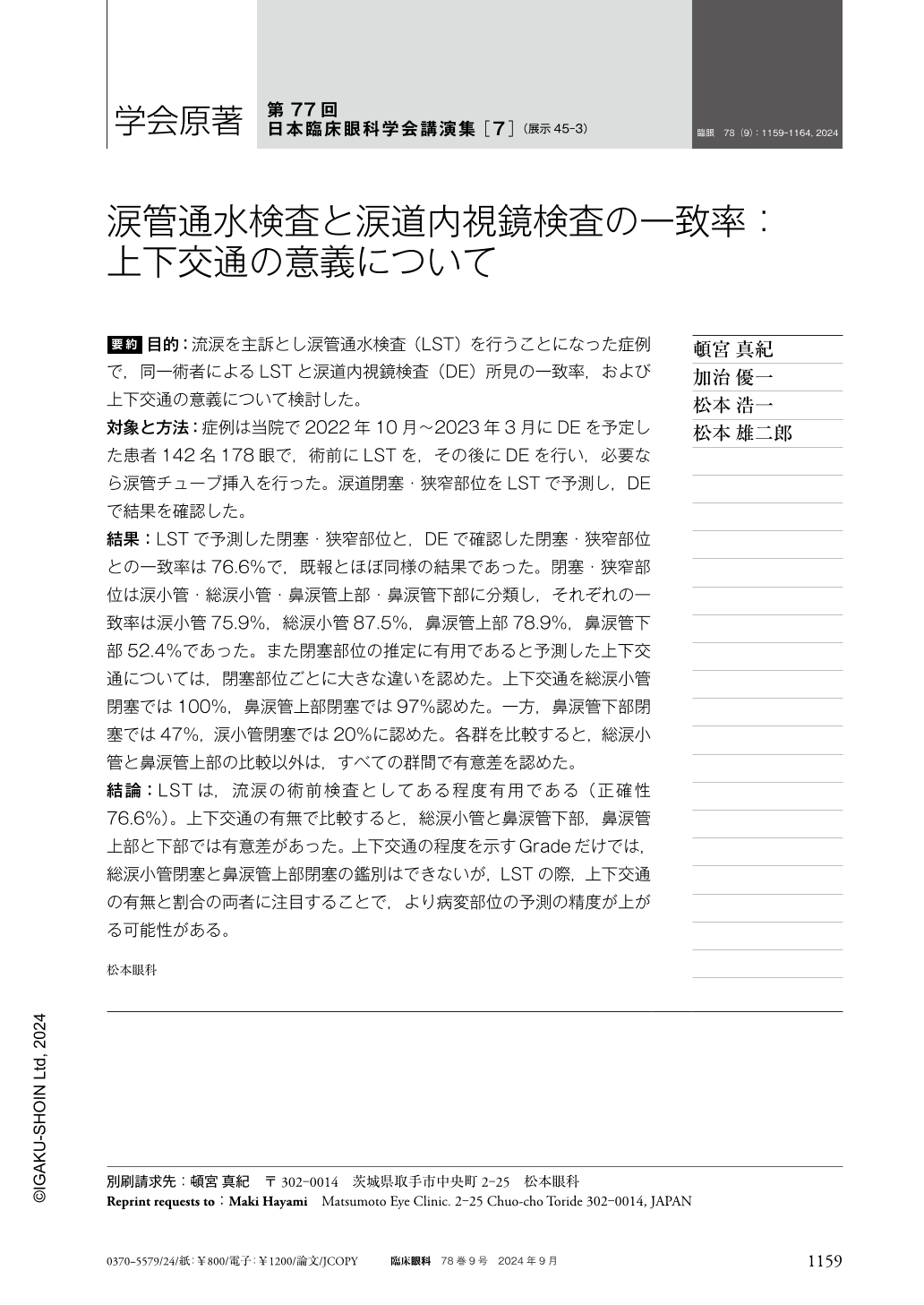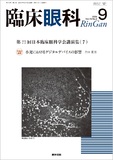Japanese
English
- 有料閲覧
- Abstract 文献概要
- 1ページ目 Look Inside
- 参考文献 Reference
要約 目的:流涙を主訴とし涙管通水検査(LST)を行うことになった症例で,同一術者によるLSTと涙道内視鏡検査(DE)所見の一致率,および上下交通の意義について検討した。
対象と方法:症例は当院で2022年10月〜2023年3月にDEを予定した患者142名178眼で,術前にLSTを,その後にDEを行い,必要なら涙管チューブ挿入を行った。涙道閉塞・狭窄部位をLSTで予測し,DEで結果を確認した。
結果:LSTで予測した閉塞・狭窄部位と,DEで確認した閉塞・狭窄部位との一致率は76.6%で,既報とほぼ同様の結果であった。閉塞・狭窄部位は涙小管・総涙小管・鼻涙管上部・鼻涙管下部に分類し,それぞれの一致率は涙小管75.9%,総涙小管87.5%,鼻涙管上部78.9%,鼻涙管下部52.4%であった。また閉塞部位の推定に有用であると予測した上下交通については,閉塞部位ごとに大きな違いを認めた。上下交通を総涙小管閉塞では100%,鼻涙管上部閉塞では97%認めた。一方,鼻涙管下部閉塞では47%,涙小管閉塞では20%に認めた。各群を比較すると,総涙小管と鼻涙管上部の比較以外は,すべての群間で有意差を認めた。
結論:LSTは,流涙の術前検査としてある程度有用である(正確性76.6%)。上下交通の有無で比較すると,総涙小管と鼻涙管下部,鼻涙管上部と下部では有意差があった。上下交通の程度を示すGradeだけでは,総涙小管閉塞と鼻涙管上部閉塞の鑑別はできないが,LSTの際,上下交通の有無と割合の両者に注目することで,より病変部位の予測の精度が上がる可能性がある。
Abstract Purpose:This study aimed to evaluate the concordance between lacrimal syringing test(LST)and dacryoendoscopy(DE)findings in cases presenting with epiphora and scheduled for lacrimal duct examinations, all performed by the same surgeon. The study also investigated the significance of communication between upper and lower canaliculi in these examinations.
Methods:A total of 142 patients(178 sides)scheduled for dacryoendoscopy(DE)from October 2022 to March 2023 were included in the study. The following steps were carried out in chronological order:lacrimal syringing test(LST)was performed, followed by DE, and then by lacrimal tube insertion if necessary. Obstruction or stenosis sites were predicted using LST and confirmed by DE.
Results:The concordance rate between predicted obstruction or stenosis sites by LST and those confirmed by DE was 76.6%, which was consistent with previous reports. The obstruction or stenosis sites were classified into the following:lacrimal canaliculus, common canaliculus, upper nasolacrimal duct, and lower nasolacrimal duct, with concordance rates of 75.9%, 87.5%, 78.9%, and 52.4%, respectively. Regarding the utility of estimating communication between upper and lower canaliculi, significant differences were observed among different obstruction sites. The presence of communication between upper and lower canaliculi varied with 100% for common canaliculus, 97% for upper nasolacrimal duct, 47% for lower nasolacrimal duct, and 20% for lacrimal canaliculus. When comparing the frequency of communication between upper and lower canaliculi among the groups, significant differences were observed in all groups except between common canaliculus and upper nasolacrimal duct.
Conclusion:Lacrimal syringing test is reasonably useful as a preoperative examination for epiphora, with an accuracy of 76.6%. There were significant differences in the presence of communication between upper and lower canaliculi, especially between common canaliculus and lower nasolacrimal duct, and between upper and lower nasolacrimal ducts. Discriminating between common canaliculus obstruction and upper nasolacrimal duct obstruction based solely on the degree of communication between upper and lower canaliculi is challenging. However, focusing on both the presence and ratio of communication between upper and lower canaliculi during LST may enhance the accuracy of predicting the obstruction or stenosis sites.

Copyright © 2024, Igaku-Shoin Ltd. All rights reserved.


